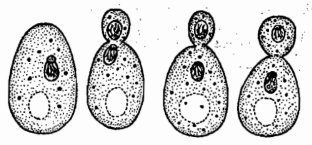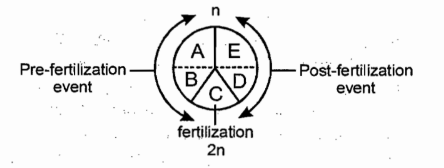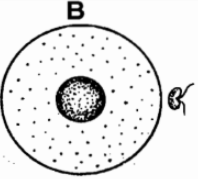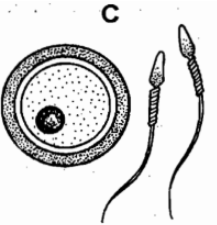The period from birth to the natural death of an organism represents-
1. Reproductive phase
2. Life cycle
3. Life span
4. Life style
No individual is immortal except-
1. Single-celled organisms
2. Green plants
3. Sponges
4. Drones
find out the correct statement-
1. Life spans of organisms are necessarily correlated with their sizes
2. The sizes of crows and parrots are not very different, so their life spans are almost similar
3. A peepal tree has much shorter life span as compared to a mango tree
4. Reproduction is essential for continuity of species on the earth
Which of the following sequences of organisms is correct in respect of life spans?
1. Banyan tree>Parrot>Elephant>Crocodile>Crow
2. Crow>Crocodile>Elephant>Parrot>Banyan tree
3. Banyan tree>Elephant>Crocodile>Parrot>Crow
4. Crow>Parrot>Elephant>Crocodile>Banyan tree
Find out the organism with highest life span-
1. Tortoise
2. Horse
3. Dog
4. Fruit fly
The life span of tortoise is-
1. 100-150 years
2. 250 years
3. 20 years
4. 1 year
"How organisms reproduce" - depends upon-
1. Habitat of organisms
2. Internal physiology of organisms
3. Genetic make up
4. All of the above factors
which of the following is a false statement?
1. All organisms have evolved a similar mechanism to multiply and produce offsprings
2. Asexual reproductions is uniparental
3. Sexual reproduction is biparental
4. In asexual reproduction, no fertilization occurs
Individuals of a clone-
1. Are genetically similar but morphologically different
2. Are morphologically similar but genetically different
3. Are morphologically and genetically similar
4. Are genetically and phenotypically different
Clone is the product of-
1. Sexual reproduction
2. Sexual or asexual reproduction
3. Amphimixis
4. Asexual reproduction
Asexual reproduction is common-
1. Among single called organisms only
2. Among plants only
3. Among single-celled organisms, plants and all animals
4. Among single called animals, plants and animals with simple organization
In Monerans (e.g. bacteria) and Protists (Amoeba, Paramecium, Euglena, etc) asexual reproduction occurs by -
1. Budding
2. Multi fission
3. Binary fission
4. Amphimixis
Among the following which one is not a method of asexual reproduction-
1. Budding (e.g.yeast)
2. Layering
3. Sowing
4. Binary fission

The above figure refers to which type of reproduction in yeast?
(1) Binary fission
(2) Budding
(3) Layering
(4) Fusion
In animals and other simple organisms uniparental reproduction is called____________reproduction,in plant it is called _________ reproduction
1. vegetative, asexual
2. Asexual, vegetative
3. Parthenogenetic, Amphimictic
4. Amphimictic, Apomictic
Which of the following is not vegetative propagule?
1. Rhizome and sucker
2. Tuber and offset
3. bulbil(e.g. in Agave), leaf buds, bulb
4. Antherozoid
Identify A to D in given diagrams showing asexual reproductive structure
(1) A - Zoogamete, B - Conidia, C - Bud, D - Gemmule
(2) A−Z oospore, B− Conidia, C - Bud, D - Gemmule
(3) A - Zoospore, B - Conidiosporangium, C - Bud, D - Gemmule
(4) A - Aplanospore, B - Conidia, C - Bud, D - Gemmule
Examine the figure given below and select the right options out of ( a - d); in which all the 4 items A, B, C and D are identified correctly-
A B C D
Tuber Rhizome Bulb Leaf buds
Offset Sucker Stolon Leaf buds
Offset Sucker Stolon Leaf buds
Tuber Rhizome Bulb Leaf buds
a. The plant was introduced in India because of its beautiful flowers and shape of leaves
b. It can propagate vegetatively at a phenomenal rate and spread all over water body in a short period
c. it is very difficult to get rid off these plants
A to C point are related to-
1. Dahlia
2. Water hyacinth
3. Azolla (water fern)
4. Mosses
Which of the following statements is false?
1. Asexual reproduction is simpler than sexual reproduction
2. Asexual reproduction occurs by fission, budding and fragmentation
3. In most of the animals both asexual and sexual modes of reproduction are found
4. Vegetative and sexual modes of reproduction are exhibited by the higher plants
Some organisms are capable of asexual or sexual reproduction. Under favourable asexually. When conditions become more stressful reproduction switches to a sexual mode. why
(1) Sexual reproduction is simple and more rapid allowing larger numbers of offspring to be produced
(2) Sexual reproduction requires two separate individuals, who can mutually provide nutrient support during stress
(3) Sexual reproduction produces individuals with new combinations of recombined chromosomes increasing diversity
(4) Asexual reproduction requires more energy
The fastest method to obtain clones is through-
1. induced mutation
2. parasexual hybridization
3. parthenogenesis
4. vegetative reproduction
Which of the following is cultivated through vegetative propagation-
1. Potato and Sugarcane
2. Banana and Ginger
3. Dahlia and Rose
4. All
The site origin of the new plantlets in potato, dahlia, ginger, and banana is-
1. Floral buds present on stem
2. Internodes of modified stem
3. Nodes of modified stem
4. Adventitious buds present on root
Internal fertilization occurs in-
1. Many fungi
2. Reptiles: mammals
3. Bryophytes, pteridophytes, gymnosperms, angiosperms
4. All
Which of the following is false about external fertilization?
1. Organisms showing external fertilization exhibit great synchrony between the sexes and release gametes
2. Gametes are produced in large number in water to enhance the chances of fertilization
3. A large number of gametes are wasted
4. A major advantage is that the offsprings are protected from predators and there is a up to adulthood.
Which of the following is false about internal fertilization?
I. Male gamete is motile
II. Male gametes are non-motile
III. Male gametes are produced in large number
IV. Male gametes are produced in small number
V. There is a significant reduction in the number of eggs produced
VI. In seeded plants non-motile male gametes are carried to female gamete by P
(1) I, III, V, V
(2) III, IV
(3) ∥1,∥
Which of the following is correct?
1. Asexual reproduction is an elaborate, complex and slow process as compared to sexual reproduction
2. Cockroach is bisexual
3. Strobllanthus kunthiana (neelakuranji) flowers every year in June
4. Date palm and Papaya are dioecious plants
Select the correct sequence from the following -
(1) Gametogenesis → Syngamy →Zygote → Embryogenesis
(2) Gametogenesis →Syngamy →Embryogenesis → Zygote
(3) Zygote → Embryogenesis → Gametogenesis
(4) Syngamy → Gametogenesis → Zygote → Embryogenesis
Select the correct sequence from the following.
I. Juvenile phase → Senescent phase → Reproductive phase
II. Juvenile phase → Reproductive phase → Senescent phase
III. Reproductive phase → Juvenile phase → Senescent phase
IV. Vegetative phase → Reproductive phase → Senescent phase
(1) I and II
(2) I and IV
(3) III and IV
(4) II and IV
Which of the following plants do not show clear cut vegetative, reproductive and senescent phase?
1. Perennial plants
2. Annual plants
3. Biennial plants
4. Either 2 or 3
Which of the following plants exhibits unusual flowering phenomenon-
1. Mango and Litchi
2. Mango and Maize
3. Litchi and Pea
4. Bamboo species and Strobilanthus species
I. Bambo species flower only once in their life time, generally after 50-100 years, produce large number of fruits and die.
II. In animals the juvenile phase is followed by morphological and physiological changes prior to active reproductive behaviour.
III. The reproductive phase is of same duration in all organisms.
IV. Juvenile phase is the period of growth between the birth of an individual till it reaches reproductive maturity.
V. In plants juvenile phase is also called vegetative phase.
Which of the following statements is false -
(1) I
(2) II
(3) III
(4) V
Which of the following is correct about Strobilanthus kunthiana?
1. If flowers once in 12 years.
2. The plant came to flower last time in September-October 2006.
3. Its mass flowering converted large hilly tracts of Kerala, Karnataka and Tamil Nadu into blue stretches that
4. All
The parameter(s) of senescence or old age is/are-
1. End of the reproductive phase
2. Concomitant change in the body(like slowing metabolism)
3. Failure of metabolism decreases
4. 1 and 2

Identify the events (A,B,D and E) in life of general reproduction −
(1) A - Gamete transfer, B - Gametogenesis, D - Zygote formation, E. - Embryogenesis
(2) A - Gametogenesis, B - Gamete transfer, D - Zygote formation, E - Embryogenesis
(3) A - Gametogenesis, B - Zygote formation, D - Gamete transfer, E - Embryogenesis
(4) A - Gametogenesis, B - Gamete transfer, D - Embryogenesis, E - Zygote formation
![]()


Identify gametes (A, B and C) respectively-
1. Heterogametes, isogametes, Homogametes
2. isogametes, homogametes, heterogametes
3. Homogametes, isogametes, heterogametes
4. Homo/Isogametes, heterogametes, heterogametes
In a majority of sexually reproducing organisms, the gametes are-
1. Isogametes
2. Homogametes
3. Hemigametes
4. Heterogametes
In heterogamous organisms the male gamete and female gametes are called respectively -
(1) Spermatogonia, oogonia
(2) Spermatid, ootid
(3) Antherozoid (sperm), Egg (ovum)
(4) Sperm and oospore
In which of the following water is essential for fertilization -
(1) Algae
(2) Bryophytes
(3) Pteridophytes
(4) All
In majority of organisms male gamete is _________ and female gamete is ____________.
1. Motile, motile
2. Non-motile, non-motile
3. Non-motile, motile
4. Motile, stationary (non-motile)
In flowering plants both male and female gametes are non-motile. The method to bring them together for fertilization is-
1. Water only
2. Air-only
3. Pollination
4. Apomixis
Ploidy of ovary, anther, egg, pollen, male gamete and zygote are respectively-
1. 2n, 2n, n, 2n, n, 2n
2. 2n, 2n, n, n, n, 2n
3. 2n, n, n, n, n, n,
4. 2n, 2n, n, 2n, 2n, 2n
Which of the following statements is true about water hyacinth?
1. It gives useful products to be used in medicine
2. It is a marine plant
3. It takes oxygen from water which causes the death of fishes
4. It is being cultivated in seawater for biogas
Monoecious plant of chara shows the occurrence of
1. Stamen and carpel on the same plant
2. Upper antheridium and lower oogonium on the same plant
3. Upper oogonium and lower antheridium on the same plant
4. Antheridiophore and archegoniophore on the same plant
ark the statements as True (T) or (F) respectively.
I. Reproduction takes place in the juvenile stage of the life cycle.
II. Eyes of potato tuber are condensed internode
III. During embryogenesis, zygote undergoes cell division and cell differentiation.
IV. Sexual reproduction is a complex and elaborate process.
1. T, F, T, F
2. F, T, T, F
3. F, F, T, T
4. T, T, F, F
The number of chromosomes in meiocyte (2n) in apple is
1. 24
2. 380
3. 34
4. 20
The chromosome number in meiocyte is 34. The organism could be
1. Ophioglossum
2. Dog
3. Onion
4. Apple
Which of the following pairs is not correctly matched?
Mode of reproduction Example
1. Binary fission Sargassum
2. Conidia Penicillium
3. Offset Water hyacinth
4. Rhizome Banana
What is Biopiracy?